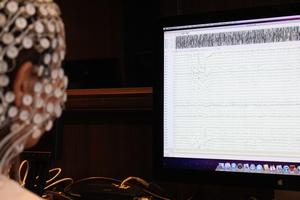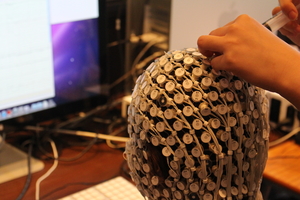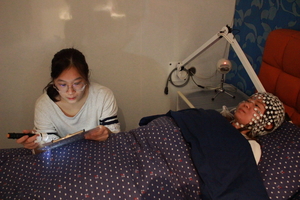NEUROPSYCHOLOGY LABORATORY
歡迎點擊瀏覽神經心理學實驗室的中文網站





Prof. YU, Kai-Ching Calvin
Ph.D., University of Cape Town, S.A.
M.Sc., University College London, U.K.
M.Sc., University College London and the Anna Freud Centre, U.K.
Grad.Dip., University College London, U.K.
B.Sc., Middlesex University, U.K.
Hon.Dip., Hong Kong Shue Yan University, H.K.
The Neuropsychology Laboratory consists of the Neuromodulation and High-Density Electroencephalography Sections. The Neuromodulation Section is located at LG304 of the Main Academic Building. The High-Density Electroencephalography (HD-EEG) Section is located in LG308 of the Research Complex. They house a 256-channel EEG system and other hardware and software programmes for measuring electrical activities of the brain (EEG), heart (EKG), and muscles (EMG) and other physiological activities, such as eye and body movements. In addition, the Neuromodulation Section is furnished with equipment for high-definition transcranial electrical stimulation. The Neuropsychology Laboratory provides students with both credit bearing and non-credit bearing research experiences at all levels (e.g., Undergraduate Research Apprentice, Research Internship, Research Mentorship, MPhil, PhD).
Mx. HOU Yanwen Schuyler (Ph.D. Student)
Mr. SUNG Kwan Kit Marco (Ph.D. Candidate)
Sleep and Dreaming
Yu, C. K.-C. (2020). We dream about typical themes in both REM and non-REM sleep. Dreaming, 30(4), 317–328.
Yu, C. K.-C. (2020). Green and dreams can facilitate creativity. Dreaming, 30(1), 92-99.
Yu, C. K.-C., & Wong, S.-S. (2020). Lucid dreaming as a correlate of locus of control and resilience. Dreaming, 30(1), 19-28.
Yu, C. K.-C. (2019). A skeleton key to dream interpretation. International Journal of Dream Research, 12(1), 1-33.
Yu, C. K.-C. (2018). Pathological narcissism, dream experiences, and personality dynamics. Dreaming, 28(4), 322-336.
Yu, C. K.-C., & & Fung, C.-M. (2018). Letting go of the ego: Dreams about ego-centered concerns as a function of adversity, Taoist orientation, and locus of control. Dreaming, 28(1), 84-98.
Yu, C. K.-C., & Li, W.-O. (2018). Examining dense-array electroencephalographic networks during sleep – Partial or non-partial correlations? Sleep and Hypnosis, 20(4), 253-261.
Yu, C. K.-C. (2018). Why is self-report of sleep position sometimes unreliable? Sleep and Hypnosis, 20(2), 105-113.
Yu, C. K.-C., & Li, W.-O. (2018). A fundamental question about the application of high-density electroencephalography and time-series analysis in examining synchronous networks during sleep – Does the use of different referencing and data preprocessing methods really matter? Sleep and Hypnosis, 20(1), 67-84.
Yu, C. K.-C. (2018). Dream Motif Scale – Short Form. Sleep and Hypnosis, 20(1), 8-16.
Yu, C. K.-C., & Lam, T.-C. (2017). Does eating a fourth meal (siu-yeh) before bedtime affect sleep quality and dream experiences? International Journal of Dream Research, 10(1), 23-29.
Yu, C. K.-C. (2016). We dream typical themes every single night. Dreaming, 26(4), 319-329.
Yu, C. K.-C. (2016). A neuroanatomical framework for understanding dream content. Sleep and Hypnosis, 18(4), 82-91.
Yu, C. K.-C. (2016). Classification of typical dream themes and implications for dream interpretation. Neuropsychoanalysis, 18(2), 133-146.
Chan, Y.-M., & Yu, C. K.-C. (2016). Qi stagnation and its manifestations in dreams. International Journal of Dream Research, 9(2), 124-129.
Yu, C. K.-C. (2016). The Yellow Emperor’s Canon of Internal Medicine and the interpretation of typical dreams two millennia ago. Dreaming, 26(3), 250-269.
Hsu, S. S., & Yu, C. K.-C. (2016). Content analysis of Chinese dreams – Pleasure or pain? Dreaming, 26(3), 208-220.
Yu, C. K.-C. (2016). Obsessions at night: Dream experiences, emotional attributes, and personality traits as indicators of sleep problems. Sleep and Hypnosis, 18(2), 30-40.
Yu, C. K.-C. (2016). Can students’ dream experiences reflect their performance in public examinations? International Journal of Dream Research, 9(1), 15-21.
Yu, C. K.-C., & Thompson, N. S. (2016). Sleep problems and the phenomenological factors of dreaming. Sleep and Hypnosis, 18(1), 8-18.
Yu, C. K.-C. (2015). The vicissitudes of affective valence across the night: A high-density electroencephalographic study. Dreaming, 25(4), 274-290.
Yu, C. K.-C. (2015). One hundred typical themes in most recent dreams, diary dreams, and dreams spontaneously recollected from last night. Dreaming, 25(3), 206-219.
Yu, C. K.-C. (2015). What cannot kill you will make you stronger – Traumatization, dreaming, and performance in public examinations. Sleep and Hypnosis, 17(1-2), 1-10.
Yu, C. K.-C. (2015). A high-density electroencephalographic study of synchronous networks during rapid-eye-movement sleep. Dreaming, 25(1), 1-17.
Yu, C. K.-C. (2014). Psychopathological symptoms as a function of trauma, dreams, and inhibitions. Dreaming, 24(4), 309-322.
Yu, C. K.-C. (2014). Normality, pathology, and dreaming. Dreaming, 24(3), 203-216.
Yu, C. K.-C. (2014). Toward 100% dream retrieval by rapid-eye-movement sleep awakening: A high-density electroencephalographic study. Dreaming, 24(1), 1-17.
Yu, C. K.-C. (2013). Superego and the repression of affective and dream experiences. Dreaming, 23(4),266-276.
Yu, C. K.-C. (2013). Lust, pornography, and erotic dreams. Dreaming, 23(3), 175-193.
Yu, C. K.-C. (2013). The structural relations between the superego, instinctual affect, and dreams. Dreaming, 23(2), 145-155.
Yu, C. K.-C. (2013). Obsessive-compulsive distress and its dynamic associations with schizotypy, borderline personality, and dreaming. Dreaming 23(1), 46-63.
Yu, C. K.-C. (2012). Testing the factorial structure of the Dream Intensity Scale. Dreaming, 22(4), 284-309.
Yu, C. K.-C. (2012). Pornography consumption and sexual behaviors as correlates of erotic dreams and nocturnal emissions. Dreaming, 22(4), 230-239.
Yu, C. K.-C. (2012). The effect of sleep position on dream experiences. Dreaming, 22(3), 212-221.
Yu, C. K.-C. (2012). Dream Motif Scale. Dreaming, 22(1), 18-52.
Yu, C. K.-C., & Fu, W. (2011). Sex dreams, wet dreams, and nocturnal emissions. Dreaming, 21(3), 197-212.
Yu, C. K.-C. (2011). Pain in the mind: Neuroticism, defense mechanisms, and dreaming as indicators of hysterical conversion and dissociation. Dreaming, 21(2), 105-123.
Yu, C. K.-C. (2011). The mechanisms of defense and dreaming. Dreaming, 21(1), 51-69.
Yu, C. K.-C. (2011). The constancy of typical dreams. Asia Pacific Journal of Counselling and Psychotherapy, 2(1), 51-70.
Yu, C. K.-C. (2010). Recurrence of typical dreams and the instinctual and delusional predispositions of dreams. Dreaming, 20(4), 254-279.
Yu, C. K.-C. (2010). Dream intensity profile as an indicator of the hysterical tendencies to dissociation and conversion. Dreaming, 20(3), 184-198.
Yu, C. K.-C. (2010). Dream Intensity Scale: Factors in the phenomenological analysis of dreams. Dreaming, 20(2), 107-129.
Yu, C. K.-C. (2010). Contemporary Chinese sex symbols in dreams. Dreaming, 20(1), 25-41.
Yu, C. K.-C. (2009). Paranoia in dreams and the classification of typical dreams. Dreaming, 19(4), 255-272.
Yu, C. K.-C. (2009). Confirming the factor structure of the Dream Intensity Inventory. Dreaming, 19(2), 97-107.
Yu, C. K.-C. (2009). Delusions and the factor structure of typical dreams. Dreaming, 19(1), 42-54.
Yu, C. K.-C. (2008). Ancient Chinese sex symbols in dreams. Dreaming, 18(3), 158-166.
Yu, C. K.-C. (2008). Dream Intensity Inventory and Chinese people’s dream experience frequencies. Dreaming, 18(2), 94-111.
Yu, C. K.-C. (2008). Typical dreams experienced by Chinese people. Dreaming, 18(1), 1-10.
Yu, C. K.-C. (2007). Dream recall and the dissociation between dream cessation and neurological memory disorders. Neuro-Psychoanalysis, 9(2), 213-221.
Yu, C. K.-C. (2007). Emotions before, during, and after dreaming sleep. Dreaming, 17(2), 73-86.
Yu, C. K.-C. (2007). Cessation of dreaming and ventromesial frontal-region infarcts. Neuro-Psychoanalysis, 9(1), 85-92.
Yu, C. K.-C. (2006). Memory loss is not equal to loss of dream experience: A clinicoanatomical study of dreaming in patients with posterior brain lesions. Neuro-Psychoanalysis, 8(2), 191-198.
Yu, C. K.-C. (2006). Facilitating dream recall in Chinese people. Dreaming, 16(3), 186-195.
Yu, C. K.-C. (2006). Commentary on Simon Boag’s ‘Freudian dream theory, dream bizarreness, and the disguise-censor controversy’. Neuro-Psychoanalysis, 8(1), 53-59.
Yu, C. K.-C. (2005). A paradox of studying dream alteration in patients with pontine lesions. Neuro-Psychoanalysis, 7(2), 85-90.
Yu, C. K.-C. (2004). Beliefs and opinions regarding hypnosis and its applications among Chinese professionals in medical settings. Contemporary Hypnosis, 21(4), 177-186.
Yu, C. K.-C. (2003). Neuroanatomical correlates of dreaming, III: The frontal-lobe controversy (dream censorship). Neuro-Psychoanalysis, 5(2), 159-169.
Yu, C. K.-C. (2001). Neuroanatomical correlates of dreaming, II: The ventromesial frontal region controversy (dream instigation). Neuro-Psychoanalysis, 3(2), 193-201.
Yu, C. K.-C. (2001). Neuroanatomical correlates of dreaming: The supramarginal gyrus controversy (dream work). Neuro-Psychoanalysis, 3(1), 47-59.
Yu, C. K.-C. (2000). ‘The new neuropsychology of sleep: Implications for psychoanalysis’: Commentary on J. Allan Hobson and Edward Pace-Schott’s response. Neuro-Psychoanalysis, 2(2), 212-213.


